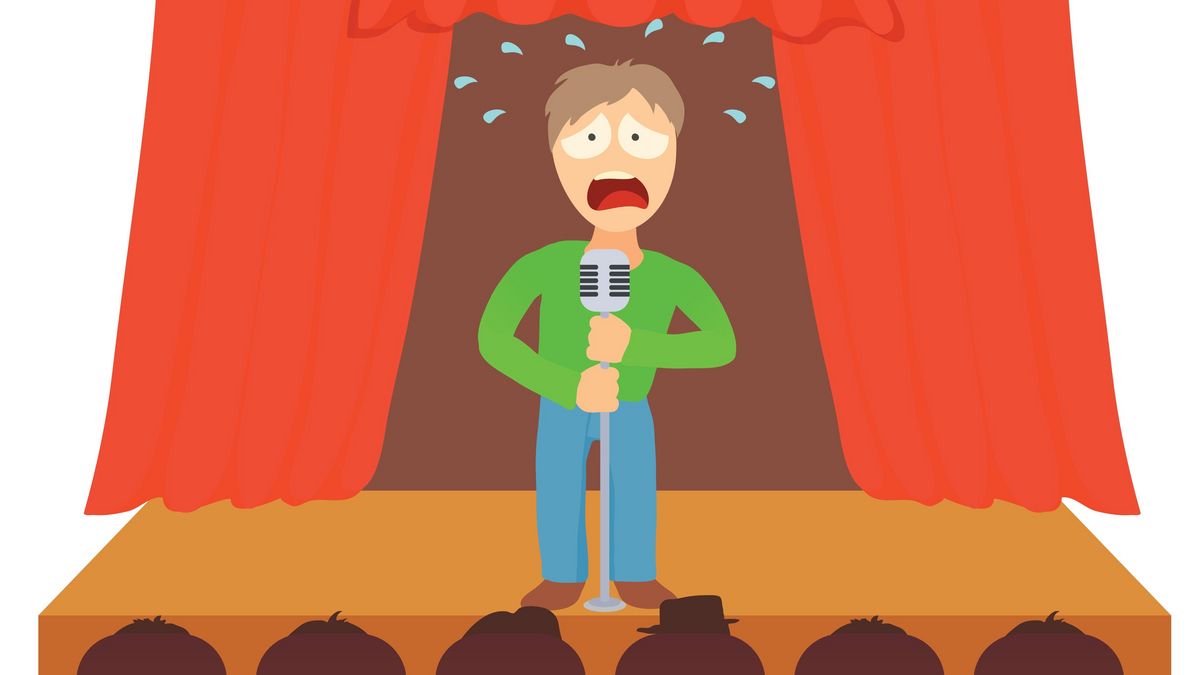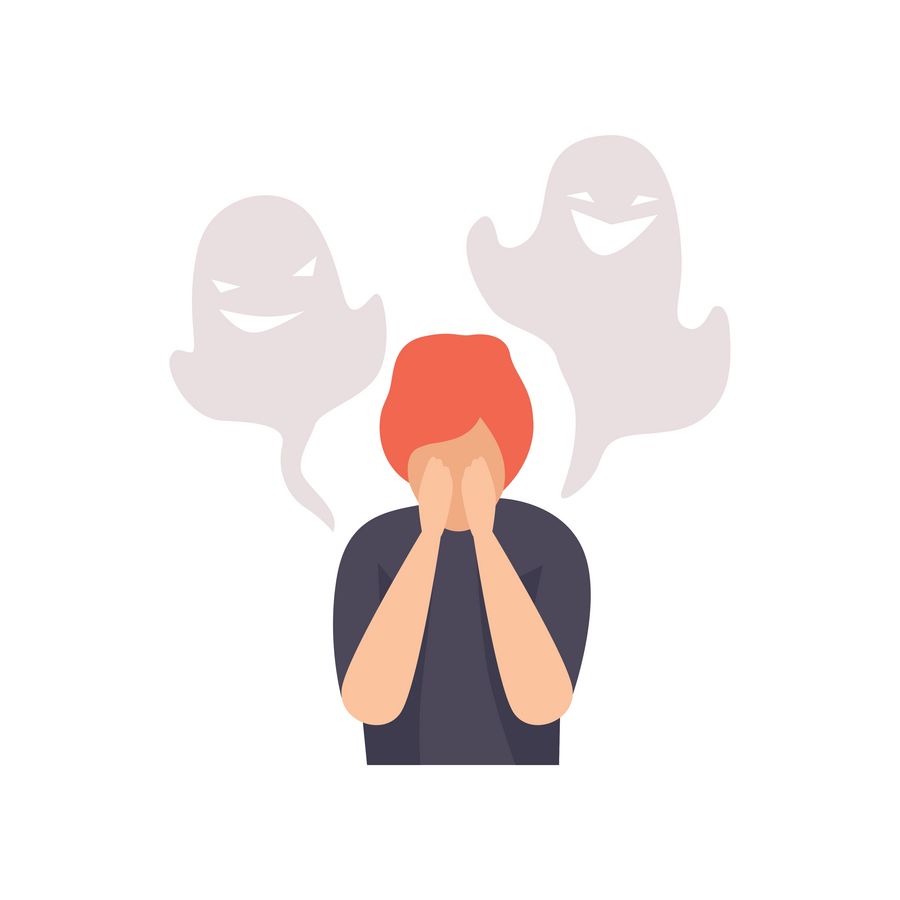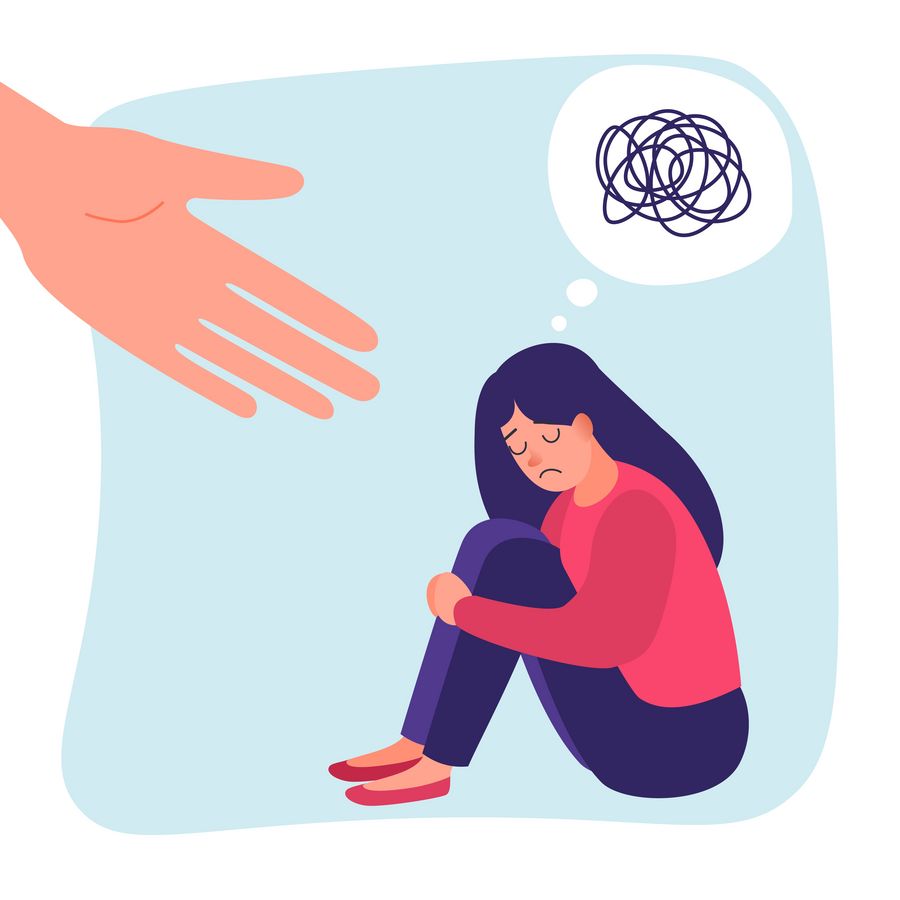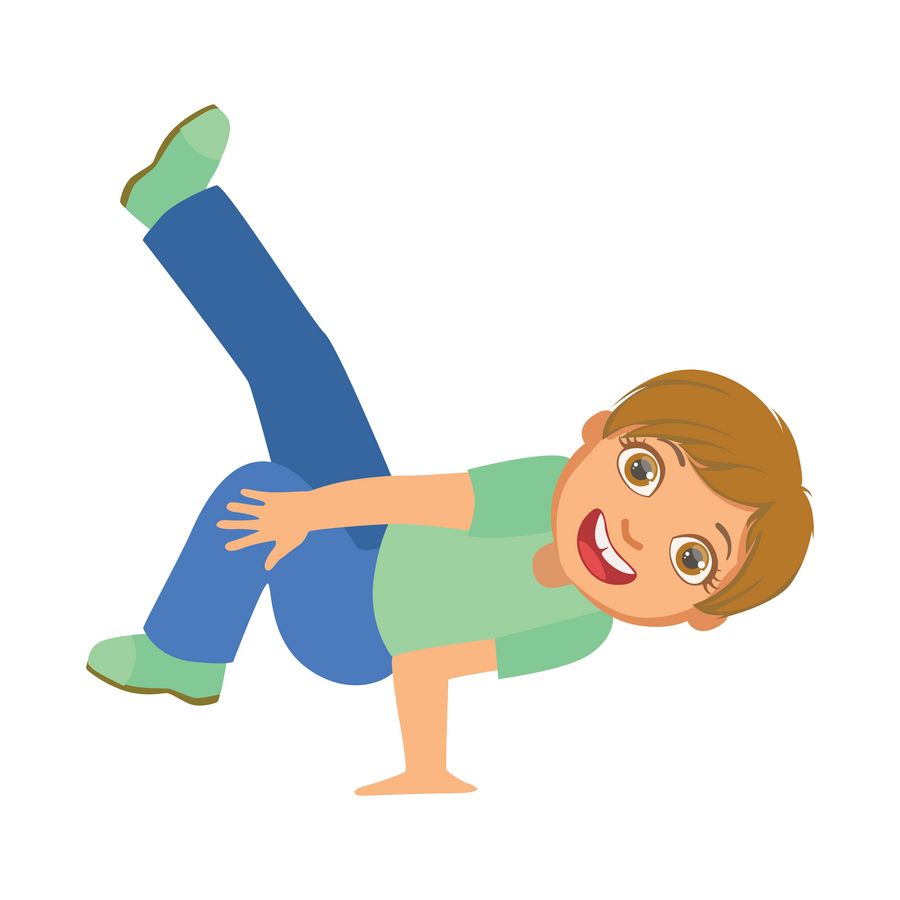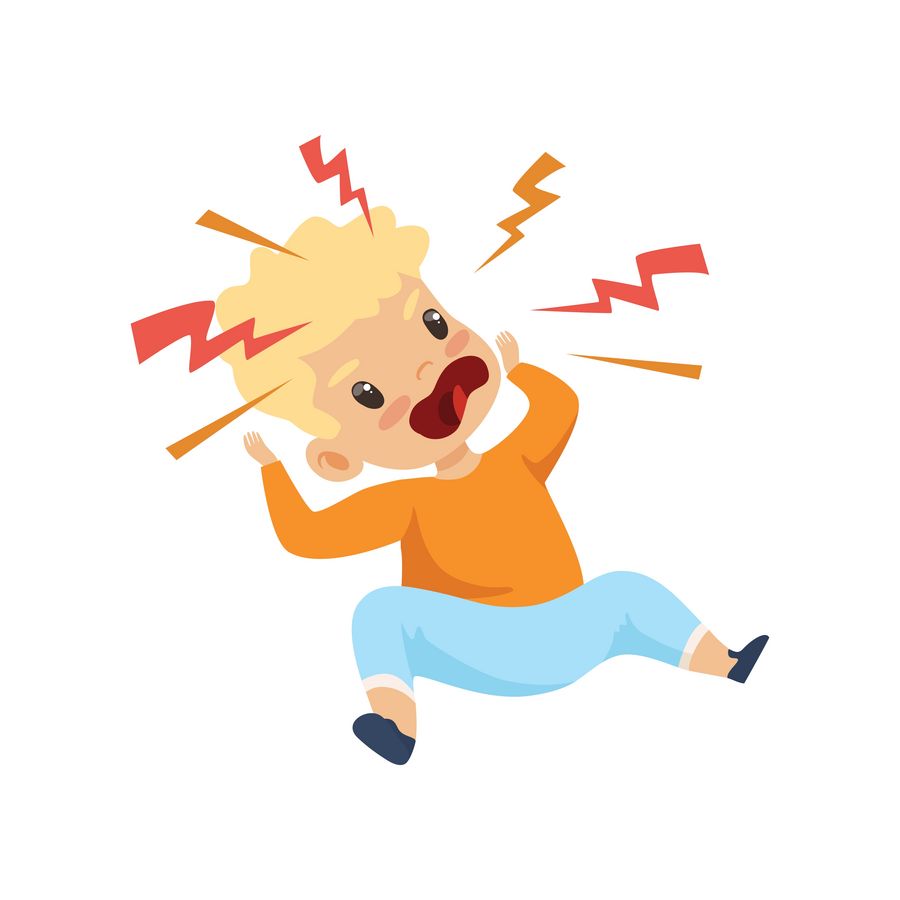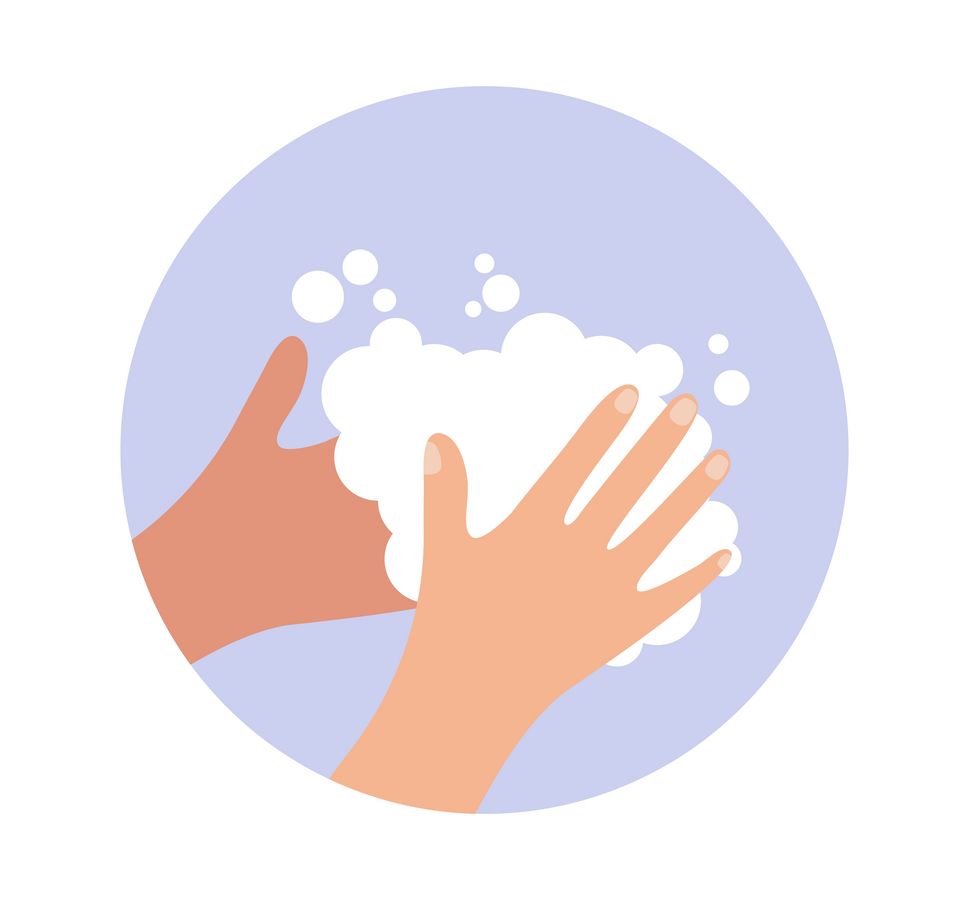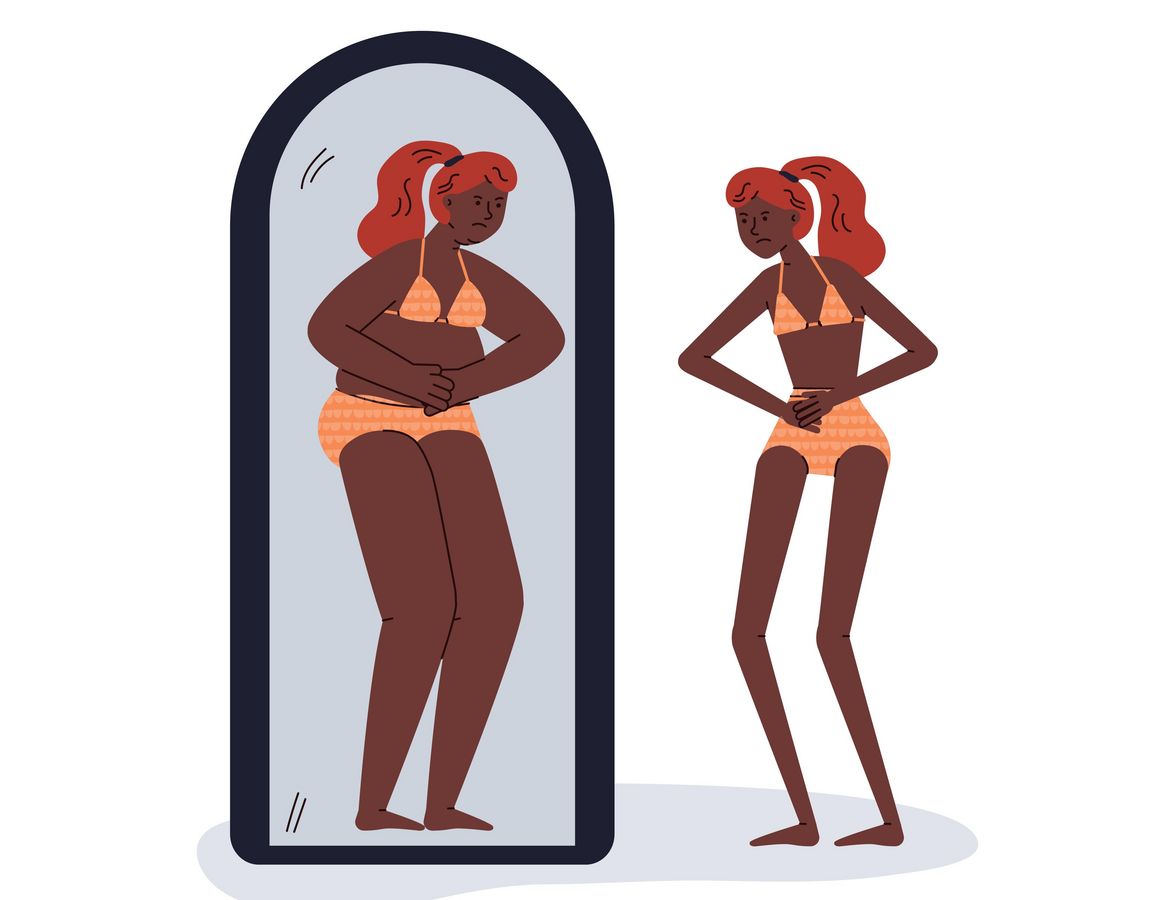On the following pages you will find information on the appearance, causes and treatment of the most common mental disorders in childhood and adolescence. Since the research focus of our group is on the development and maintenance factors of anxiety disorders in children and adolescents, we can offer special diagnostic and treatment expertise for this disorder.
Anxiety disorders
Fear is an important emotion that is integral to life and can warn us of danger. However, if fears occur very strongly and frequently and persist for a long time, if they occur regularly in situations that are not actually dangerous, certain situations are avoided because of this and everyday life is affected by them, an anxiety disorder can develop.
Anxiety disorders are among the most common mental disorders in childhood and adolescence, affecting 6 to 21% of children and adolescents, and ¾ of all anxiety disorders occur for the first time before the age of 21 (Kessler et al., 2005; Petermann & Petermann, 2017; Weniger, Nestler, & Schulze, 2013). Anxiety can also manifest itself in physical complaints such as headaches or abdominal pain; in younger children, for example, excessive crying can also be an expression of anxiety.
There are different forms of anxiety disorders, which can also occur together or in combination with other mental disorders (e.g., depression).
Specific phobias are characterized by a persistent and inappropriately strong fear of certain objects or situations, which are subsequently avoided. Often the very thought of them triggers a strong fear reaction. The objects feared can be quite different: some children are afraid of certain animals (e.g. spiders), others of situations (e.g. small spaces), even natural phenomena (e.g. thunderstorms), injuries (e.g. blood) or other situations (e.g. swallowing) can become a phobia.
Specific phobias are not uncommon, affecting approximately 7% to 9% of 6- to 18-year-olds (Costello, Copeland, & Angold, 2011; Schlup & Schneider, 2009). They have the earliest onset of all phobias and can occur as early as infancy.
There are different explanations for the development of a specific phobia. Learning experiences are most likely very important, for example when a child observes fearful behavior in another person ("model learning") or has had a negative experience with the object/situation himself/herself (e.g., being bitten by a dog). However, genetic factors also play a role. An important part in the maintenance of phobic disorders is the avoidance behavior. By avoiding the feared objects or situations (e.g. dogs), children/adolescents no longer experience a fear reaction in connection with them. This lack of fear in turn reinforces the assumption that "dogs are dangerous", because if the avoidance of dogs leads to no more fear occurring, the brain thinks that "there must really be some truth in the fear". Consequently, dogs are avoided even more and there is no possibility to have new, positive experiences with the animal.
In a panic disorder, sudden "panic attacks" occur regularly. In this case, the fear increases very strongly within a short time and physical phenomena such as dizziness, palpitations or chest pain and sometimes even the fear of death occur. Such anxiety attacks can also occur in the context of other anxiety disorders (e.g. phobias), but the characteristic of panic disorders is that the occurrence is not predictable and is not limited to certain situations, for example.
Panic disorders are rather uncommon in childhood, occurring in 0.5 to 1.5% of children and adolescents (Costello et al., 2011).
One model used to explain panic disorders is the "vicious cycle of anxiety." This proposes that external stimuli (e.g., climbing stairs) cause physical changes (e.g., increased heart rate). If these changes are evaluated as "dangerous", fear or panic occurs and as a result physical changes (e.g. trembling) occur again, which in turn are again perceived as "dangerous" - a "vicious circle" begins. The development of this disorder is also facilitated by genetic factors and learning experiences (e.g. of uncontrollable situations).
Generalized Anxiety Disorder is characterized by frequent worries and concerns about various topics (e.g., failure at school, future misfortune) that are experienced as uncontrollable. Children with Generalized Anxiety Disorder are often referred to as "little adults" because worries often center around issues typical of adults, such as health and finances. Affected children and adolescents are often very tense and feel restless, sleep and concentration problems are also common. Also, physical complaints without medical cause, such as abdominal pain and headaches, may occur. Perfectionistic behavior is also typical, which is why the children are often judged as more mature or conscientious than their peers.
Although Generalized Anxiety Disorder most commonly begins in middle adulthood, it also affects approximately 1.7% to 1.9% of children and adolescents (Beesdo, Kappe, & Pine, 2009; Costello et al., 2011).
Important developmental factors include an overanxious temperament, genetic influences, and neurobiological factors. Environmental factors such as parental overprotection also play a role. In addition, abnormalities in information processing are observed in affected children and adolescents; for example, ambiguous situations tend to be assessed as threatening and the probability of a negative event occurring is overestimated.
In agoraphobia, affected children and adolescents are afraid of not being able to escape to a safe place in certain situations. Such situations can include crowds, public places, and traveling far from home. Sometimes the fear is so strong that the affected person does not want to leave the house at all and cannot go to school, for example. Often, so-called "panic attacks" also occur in the feared situations ("agoraphobia with panic disorder").
Agoraphobia usually begins in later adolescence and early adulthood and rarely occurs in childhood (Heiser, 2018). Among adults, it affects approximately 2% to 4% (Kindermann, Mühlberger, & Voderholzer, 2016).
Agoraphobia, like Specific Phobia, can arise from learning experiences in combination with genetic predispositions. Avoidance of the feared situations or places usually additionally intensifies the fear.
Children and adolescents with social anxiety disorder are afraid of social situations, such as interacting with other people (e.g., attending a birthday party with other children) and/or performance situations (e.g., giving a presentation at school). In doing so, they worry about being embarrassed or negatively evaluated. Various bodily reactions such as nausea, blushing, or trembling may occur in the situations in question. Social anxiety disorder can lead to a great deal of everyday impairment; for example, people affected often have a hard time making friends.
Social anxiety disorder begins before the age of 13 in about half of those affected (Beesdo-Baum & Knappe, 2012). Shyness and an inhibited temperament are often evident as early as kindergarten age. Depending on the specific study, 1 to 10% of children and adolescents are reported to have social anxiety disorder (Costello et al., 2011; Essau et al., 2000; Wittchen et al., 1999).
Biological and genetic factors, as well as learning experiences (e.g., exclusion by peers; overprotection by parents), play a role in the development of the disorder. In addition, affected children often find it difficult to deal with negative emotions and pay particular attention to stimuli that could be threatening.
Separation anxiety is a typical behavior in younger children. However, in Separation Anxiety Disorder, which can occur from preschool age onwards, there is an age-inappropriate and exceptionally strong fear of being separated from important caregivers. The affected children and adolescents also fear that something might happen to the caregivers or that they will be separated from them in some other way (e.g., by kidnapping). Because of this fear, they may, for example, refuse to stay home alone during the day, sleep alone, or go to school or kindergarten. If avoidance of the separation situation is not possible, irritable or aggressive behavior may occur (e.g., fighting). Repeated nightmares and physical complaints such as abdominal pain or nausea may also be part of the disorder.
Separation Anxiety Disorder occurs in approximately 2 to 4% of children (Costello et al., 2011; Schneider & Blatter, 2009).
To date, there is no specific explanation for the development of the disorder. It is assumed that an inhibited temperament and an insecure attachment style as well as overprotective parenting behavior and certain attention biases play a role.
In the treatment of anxiety disorders, psychoeducation takes place first. After that, various cognitive interventions can be used. Exposure/confrontation with feared objects or situations also plays a major role. Sometimes social skills training is also helpful.
Beesdo, K., Knappe, S. & Pine, D. S. (2009). Anxiety and Anxiety Disorders in Children and Adolescents: Developmental Issues and Implications for DSM-V. Psychiatric Clinics of North America, 32(3), 483–524. https://doi.org/10.1016/j.psc.2009.06.002
Beesdo-Baum, K. & Knappe, S. (2012). Developmental epidemiology of anxiety disorders. Child and Adoloscent Psychiatric Clinics of North America, 21(3), 456–478.
Costello, E. J., Copeland, W. & Angold, A. (2011). Trends in psychopathology across the adolescent years: What changes when children become adolescents, and when adolescents become adults? Journal of Child Psychology and Psychiatry and Allied Disciplines, 52(10), 1015–1025. https://doi.org/10.1111/j.1469-7610.2011.02446.x
Essau, C. A., Conradt, J. & Petermann, F. (2000). Frequency, comorbidity, and psychosocial impairment of anxiety disorders in german adolescents. Journal of Anxiety Disorders, 14(3), 263–279. https://doi.org/10.1016/S0887-6185(99)00039-0
Heiser, K. (2018). Entwicklung, Implementierung und Evaluation eines Behandlungsprogramms im teilstationären Setting für Kinder mit Angststörungen im Alter von 8-12 Jahren. Unveröffentlichte Dissertation, Ludwig-Maximilians-Universität München.
In-Albon, T. (2009). Generalisierte Angststörung. In S. Schneider & J. Margraf (Hrsg.), Lehrbuch der Verhaltenstherapie, Band 3: Störungen im Kindes- und Jugendalter (S. 593–608). Heidelberg: Springer.
Kessler R. C., Berglund P., Demler O., Jin, R., Merikangas, K. R. & Walters, E. E. (2005) Lifetime prevalence and age-of-onset distributions of DSM-IV disorders in the national comorbidity survey replication. Archives of General Psychiatry, 62, 593. https.//doi.org/ 602 10.1001/archpsyc.62.6.593
Kindermann, P., Mühlberger, M. & Voderholzer, U. (2016). Panikstörung und Agoraphobie. PSYCHup2date, 10(02), 115–132. https://doi.org/10.1055/s-0041-107999
Petermann, F., & Petermann, U. (2017). Angststörungen. Kindheit und Entwicklung, 26(2), 73–76. https://doi.org/10.1026/0942-5403/a000218
Schlup, B. & Schneider, S. (2009). Spezifische Phobien. In S. Schneider & J. Margraf (Hrsg.), Lehrbuch der Verhaltenstherapie, Band 3: Störungen im Kindes- und Jugendalter (S. 503–530). Heidelberg: Springer.
Schneider, S. & Blatter, J. (2009). Trennungsangst. In S. Schneider & J. Margraf (Hrsg.), Lehrbuch der Verhaltenstherapie, Band 3: Störungen im Kindes- und Jugendalter (S. 503–530). Heidelberg: Springer.
Weninger, L., Nestler, J. & Schulze, U. (2013). Angststörungen und phobische Störungen im Kindes- und Jugendalter. In J. M. Fegert & M. Kölch (Hrsg.), Klinikmanual Kinder- und Jugendpsychiatrie und -psychotherapie – 2. Auflage (S. 43–62). Heidelberg: Springer.
Wittchen, H. U., Stein, M. B. & Kessler, R. C. (1999). Social fears and social phobia in a community sample of adolescents and young adults: prevalence, risk factors and co-morbidity. Psychological Medicine, 29(2), 309–23.
Depression
Depression is often associated with sadness. Feeling sad and crying frequently can be an expression of a depressive disorder, but it also includes other symptoms such as a lack of joy, dejection, or lethargy, which are not always easily perceived from the outside.
Approximately 1 to 3% of children are affected by depression (Blanz, Remschmidt, Schmidt, & Warnke, 2006; Wichstrom et al., 2012). In adolescence (from about 13 years of age), the number increases significantly: to about 6-10%, with some studies even reporting 15-20% (Costello, Erkanli, & Angold, 2006; Groen, Pössel, & Petermann, 2003; Mojatabai, Olfson, & Han, 2016). A large percentage of those affected also have at least one other mental disorder. Depression has many faces, which can also change over time. Very importantly, depressive disorders can manifest differently in children and adolescents than in adults. Therefore, they are often "overlooked" and not recognized as depression.
Toddlers with depressive symptoms often appear sad and inexpressive, but can also be noticed for their frequent and "attack-like" crying. In addition, they are usually easily irritated and show little imagination, creativity and perseverance in play. Sometimes they have no interest in playing at all. Sleep disturbances and disturbed eating behavior as well as frequent "sickliness" can also be an expression of depression.
In preschool age, depressed children are also often sad, easily upset and cannot feel "really" happy at all. Some of the affected children become very withdrawn. But irritability and aggressive behavior can also be associated with a depressive illness. Often the children do not enjoy physical activities (e.g. sports games) and are generally interested in few things. Similarly, sleep disturbances (e.g., nightmares) are reported. Some children also begin to speak in "baby talk" again or to wet themselves. In play, topics such as guilt or worthlessness often come up.
At school age, the children's sad thoughts are no longer only addressed in play, but can also be told. Here, as well, aggressive behavior can be an expression of depression. In addition, the affected children often report difficulty concentrating at school, and their school performance may also decline. Often, the children also complain of stomachaches or headaches. Some children also express concern that their parents do not pay enough attention to them and seek affection. They may also express suicidal thoughts ("suicidality"). This should especially be seen as a "warning signal" and professional help should be involved.
Depressive adolescents often seem apathetic, but can also be angry or desperate at times. They often withdraw and no longer want to spend time doing things they used to enjoy. Worries about the future, self-blame, and low self-esteem are issues that adolescents often ruminate about for a long time. At school, depressive disorder often manifests itself in performance problems or difficulty concentrating. Sleep problems and "morning lows" are also reported. Adolescents often are unable to relax properly and feel physically ill, sometimes trying to "numb" their self-esteem problems and feelings with drugs or alcohol. In addition, suicidal tendencies (thoughts of one's own death and/or attempts to take one's own life) may also become a part, which is why professional support should be sought quickly.
There are many possible reasons for the development of depression. For example, a genetic predisposition, stress (e.g. at school or in the family) and distressing events (e.g. loss of an important person; separation of parents; bullying experiences) can interact. An important factor in the development and maintenance of the disorder are the thoughts that children and adolescents with depression have. These are usually not realistic. For example, positive experiences are often "downplayed" and minor deficiencies are overrated, creating a very negative image of themselves, other people, and future events. Often, so-called "automatic thoughts" occur quite suddenly (e.g., "I will definitely be expelled from school") and trigger feelings of anxiety or sadness. In addition, withdrawal from activities, as is often observed, usually has negative consequences: for example, if a child never responds to invitations to friends, he or she may eventually not be invited at all and then feel even worse as a result.
In the treatment of depressive disorders, psychoeducation is conducted first. An important part of the therapy are cognitive interventions, in which, for example, changing the children's/adolescents' negative image of themselves or acquiring strategies for dealing with negative emotions can be a goal. In addition, activity building plays an important role in which new, enjoyable activities are to be established. In some cases, social skills training is also carried out, for example, to facilitate the establishment of new friendships.
Blanz, B., Remschmidt, H, Schmidt, M. H , Warnke, A. (2006). Psychische Störungen im Kindes- und Jugendalter. (S. 357–363) Stuttgart, New York: Schattauer.
Groen, G., Pössel, P. & Petermann, F. (2003). Depression im Kindes- und Jugendalter. In F. Petermann, K. Niebank & H. Scheithauer (Hrsg.), Lehrbuch der Entwicklungswissenschaft: Entwicklungspsychologie, Genetik, Neuropsychologie. (S. 437–481). Berlin: Springer.
Costello E.J., Erkanli A., Angold A. (2006) Is there an epidemic of child or adolescent depression? Journal Of Child Psychology and Psychiatry, 47, 1263–1271.
Mojtabai, R., Olfson, M. & Han, B. (2016). National trends in the prevalence and treatment of depression in adolescents and young adults. Pediatrics, 138(6). https://doi.org/10.1542/peds.2016-1878
Pössel (2009). Depression/Suizidalität. In S. Schneider & J. Margraf (Hrsg.), Lehrbuch der Verhaltenstherapie, Band 3: Störungen im Kindes- und Jugendalter (S. 663–688). Heidelberg: Springer.
Wichstrom, L., Berg-Nielsen, T. S., Angold, A., Egger, H. L., Solheim E., & Sveen, T.H. (2012). Prevalence of psychiatric disorders in preschoolers. Journal of Child Psychology and Psychiatry, 53, 695–705.
ADHD
When people think of ADHD, they often imagine a typical "fidgety kid" - a boy who can't sit still. Hyperactivity can indeed be an important feature of this disorder, but it can also affect children who appear rather calm to the outside world (inattentive subtype). It is also important to note that girls can also have attention deficit hyperactivity disorder. However, the behaviors are more likely to be noticed in boys, which is why they are about twice to three times more likely to be diagnosed with ADHD (APA, 2018; Göbel, Baumgarten, Kuntz, Hölling, & Schlack, 2018).
ADHD is one of the most common mental disorders in childhood and adolescence. Approximately 4% to 5% of all children and adolescents receive this diagnosis during their lifetime (Göbel et al., 2018; Polanczyk, Willcutt, Salum, Kieling, & Rohde, 2014).
Depending on which symptoms are predominant, three forms of ADHD can be distinguished:
In the combinded subtype, children and adolescents show symptoms of inattention (e.g., carelessness, frequent loss of objects, distractibility) as well as hyperactivity (e.g., sliding around on a chair, frequent walking around, difficulty keeping quiet) and impulsivity (e.g., not being able to wait for one's turn, frequently interrupting others).
In contrast, in the inattentive subtype, symptoms of inattention are most noticeable, while the affected individuals are not more hyperactive or impulsive than others. In the hyperactive-impulsive subtype, the opposite is observed - hyperactive and impulsive behavior is dominant and attention is not necessarily impaired.
All of the subtypes have in common that the problems do not only occur in one area of life (e.g. school), but in at least two domains (e.g. also at home). In addition, the symptoms must have appeared for the first time before the age of 6 (according to more recent criteria, the 12th birthday is considered the "cut-off date"). Depending on the age of the children or adolescents, ADHD can appear differently.
Younger children with ADHD are often very strained and irritable and show hyperactive behavior. They tend to play without much intensity and continuity. Sometimes development may also be delayed. Strong tantrums or disobedient behavior can also be associated with ADHD. The problems are often interpreted as "naughtiness" or " wanting to be in the center of attention", which, however, is not true.
After starting school, the symptoms often become more intense. For example, the affected children often have difficulties following lessons and are restless and distractible. This can be accompanied by learning difficulties or specific learning disorders (e.g. dyslexia). Sometimes children with ADHD have to retake a year, even though they are no less intelligent than their peers. Due to their difficulties, they often also tend to behave aggressively. Because of these abnormalities, the affected children are often rejected by peers or teachers and perceived as "disruptive," from which the children usually suffer greatly. Self-esteem problems can be a major issue.
In many children with ADHD, the disorder persists into adolescence and even adulthood. A significant feature of adolescents with ADHD is that signs of physical restlessness (e.g., bouncing around in a chair) often decrease and attention problems (e.g., problems completing tasks) are more central to the disorder. Aggressive behavior may also occur at this age, and alcohol and drug abuse (sometimes as "self-medication") can also be a factor. Mood swings, anxiety or depressive moods are common as well. ADHD can have a broad impact on the individual's lifestyle; for example, those affected often perform below their potential when it comes to grades and graduation from school, and they often tend to have few friendships. Despite all limitations, many people with ADHD also have special strengths, e.g. their creativity and ideas are often very high. However, this potential cannot always be used due to the mentioned impairments.
In the therapy of ADHD, a detailed psychoeducation is first carried out with the child and his/her parents. After identifying behaviors that are particularly difficult for the child/adolescent, these are specifically trained. Cognitive interventions such as concentration exercises are important in this context. Sometimes social skills training is also helpful, for example to practice how to solve conflicts without aggression. Cooperation with parents plays a central role in the therapy of ADHD. This involves considering, for example, which rules and rituals could be introduced in the family to provide more orientation for the children, but also how the often troubled parent-child relationship could be strengthened. In the case of severe symptoms, an accompanying medical therapy (e.g. with methylphendiate) can also be considered.
Various factors can contribute to the development of ADHD. In general, the disorder is considered a "neural developmental disorder," which means that brain maturation is expected to be delayed in children with ADHD. In addition, the metabolism in the brain is probably altered. Genetic predispositions (e.g. ADHD or other mental disorders of one parent) have a large effect. Also abnormalities during pregnancy and birth (e.g. premature birth, smoking or stress during pregnancy) are reported in association with ADHD. It is assumed that there is a biological "predisposition" in these children so that they are more "sensitive" to certain stressful experiences (e.g. violence in the family, poverty) and can therefore develop ADHD symptoms. In addition, an impaired "self-regulation" is important, i.e. the children with ADHD are not able to control their attention well, which can lead to subsequent problems (e.g. they are not able to memorize rules easily). In addition, conflicts in the family and educational problems often occur - both as a cause and a consequence of the disorder - which can intensify and maintain the difficulties.
American Psychiatric Association (2018). Diagnostisches und Statistisches Manual Psychischer Störungen DSM-5 ® – 2., korrigierte Auflage. (P. Falkai & H.-U. Wittchen, Hrsg.). Göttingen: Hogrefe.
Göbel, K., Baumgarten, F., Kuntz, B., Hölling, H. & Schlack, R. (2018). ADHS bei Kindern und Jugendlichen in Deutschland – Querschnittergebnisse aus KiGGS Welle 2 und Trends. Journal of Health Monitoring, 3(3), 46–53. https://doi.org/http://dx.doi.org/10.17886/RKI-GBE-2018-078
Polanczyk, G. V., Willcutt, E. G., Salum, G. A., Kieling, C. & Rohde, L. A. (2014). ADHD prevalence estimates across three decades: An updated systematic review and meta-regression analysis. International Journal of Epidemiology, 43(2), 434–442. https://doi.org/10.1093/ije/dyt261
Schlottke P. F., Strehl, U. & Lauth, G. W. (2009). Aufmerksamkeitsstörung. In S. Schneider & J. Margraf (Hrsg.), Lehrbuch der Verhaltenstherapie, Band 3: Störungen im Kindes- und Jugendalter (S. 412–428). Heidelberg: Springer.
Conduct disorders
The fact that children are sometimes irritable, get angry, or break rules is typically part of normal development. However, in a conduct disorder, there is a significant amount of aggressive behavior and/or rule-breaking over a long period of time. Possible signs of a conduct disorder may include, for example, unusually frequent or severe outbursts of anger, bullying others, destroying other people's property, or frequent lying. Other behaviors that may occur as part of the disorder include severe rule violations such as school absenteeism, stealing, physical violence, or running away from home.
Conduct disorders can begin in both childhood and adolescence, with symptoms differing according to developmental stage. Overall, approximately 4% to 10% of children and adolescents meet diagnostic criteria for conduct disorders, but few receive appropriate treatment (APA, 2018; Stadler, 2012).
The disorder may also co-occur with other disorders such as ADHD, depression, or anxiety disorders, or as an oppositional defiant disorder. Substance use and addictions are also commonly added to the disorder as individuals age. Children and adolescents with a conduct disorder are usually very severely affected by it. They often have difficulties at school and in later working life and frequently face social stigmatization.
This disorder is a " precursor disorder" of conduct disorder, which is more common in younger children. Children affected display a persistent, intense pattern of angry or irritable mood (e.g., becoming angry quickly), argumentative or defiant behavior (e.g., frequent intentional annoyance of others), and/or revengeful behavior. Unlike conduct disorder, the behaviors are less "severe" and so do not include, for example, physical violence toward others. Nevertheless, they are usually associated with severe distress in the child him/herself and/or others (e.g., the family).
It is assumed that many risk factors are involved in the development of a conduct disorder. However, the presence of one risk factor is not sufficient here; the disorder is only pronounced when several factors interact.
For example, there are certain genetic and neurobiological characteristics, such as differences in the activation of certain brain regions, which may be associated with the disorder when certain social factors are added. Social risk factors include poverty, peer rejection, family conflict and violence, and an inconsistent, punitive parenting style. In addition, there are individual risk factors such as increased impulsivity or a distorted self-image. Abnormalities during pregnancy and birth (e.g., alcohol consumption by the mother; premature birth) can also cause changes in the central nervous system in children that are related to a disorder of social behavior.
"Model learning" also plays an important role. For example, when children are exposed to an aggressive parent, they may "copy" that aggression. This shows that aggressive children should by no means be seen only as offenders, but also as victims.
In adolescence, moreover, social groups of same-aged children (the so-called "peer groups") have a major influence, for example, in the sense of " poor role models." One theory suggests that adolescents are usually already physically developed, but not yet "properly" independent and try to demonstrate their independence from their parents and other authorities by engaging in problem behavior. In this way, they gain recognition from the "peer group," which in turn can be a role model for further problem behavior.
In the treatment of conduct disorders, the involvement of the child's social environment (e.g., family, but also school/nursery, and sometimes youth welfare institutions) is of central importance. Psychoeducation should also be provided in order to educate the social environment and the children/adolescents themselves, for example, about the underlying risk factors of the disorder, and to consider together how the disorder developed and how it is maintained.
For some parents, it is helpful to receive support in parenting, for example by working out behavioural rules, but also having a look at which activities could improve the parent-child relationship or which strengths of the family could be further developed. Cognitive interventions are realized with the child/adolescent himself/herself in therapy, where, for example, better control over feelings of anger and rage can be a goal. Social skills training, in which the handling of conflicts, for example, is trained, is also an important therapy component.
American Psychiatric Association (2018). Diagnostisches und Statistisches Manual Psychischer Störungen DSM-5 ® – 2., korrigierte Auflage. (P. Falkai & H.-U. Wittchen, Hrsg.). Göttingen: Hogrefe.
Lösel, F. & Runkel, D. (2009). Störungen des Sozialverhaltens. In S. Schneider & J. Margraf (Hrsg.), Lehrbuch der Verhaltenstherapie, Band 3: Störungen im Kindes- und Jugendalter (S. 454–480). Heidelberg: Springer.
Petermann F., Döpfner, M. & Görtz-Dorten, A. (2016) Aggressiv-oppositionelles Verhalten im Kindesalter. Göttingen: Hogrefe.
Stadler, C. (2012). Störungen des Sozialverhaltens. Zeitschrift für Kinder- und Jugendpsychiatrie und Psychotherapie, 40, 7–19.
Self-injurious behavior
Self-injurious behavior is defined as direct and intentional harm to one's own body (e.g., cutting the skin; burns) without the intention of taking one's own life. Self-injurious actions are a relatively common phenomenon among adolescents, usually beginning around age 12 to 14 (Jacobson & Gould, 2007). Approximately 1 in 5 adolescents have self-injured at some point, and approximately 9% have done so more frequently (Nixon, Cloutier, & Jansson, 2008; Plener & Kölch, 2013).
Self-injurious behaviors are very shameful for most adolescents and are therefore often tried to be hidden (e.g., by wearing long-sleeved clothing if there are injuries on the arms). The persons affected are not always shown understanding.
Self-injurious behavior is currently no independent diagnosis. It is often associated with borderline personality disorder in adults, but it can occur in the context of many other mental disorders (e.g., depression, anxiety disorder, eating disorder). In some cases, no underlying mental disorder can be identified. Importantly, the behavior should not be dismissed as "seeking attention" but should be interpreted as a possible indication of underlying problems. Although the majority of all self-injurious behaviors are not an expression of suicidal thoughts ("suicidality"), the affected adolescents are nonetheless at increased risk of later committing a suicide attempt.
One hypothesis regarding the development and maintenance of the behavior is that the affected adolescents have the feeling that they cannot counter very strong, overwhelming emotions with anything other than self-injury, and that a kind of "tension release" is experienced in the process. This is accompanied by research findings that describe discrepancies in the processing of emotions in the brain of those affected. A second theory considers self-injurious acts as a form of "self-punishment".
Psychotherapeutic treatment begins with psychoeducation of the affected adolescents and, if necessary, their families about self-injurious behaviors and possible causes. An important topic for therapy is dealing with (intense) emotions. Cognitive interventions, but also relaxation methods can be used here. In addition, strategies on how to better relieve tension are explored together. Social skills training may also be helpful.
American Psychiatric Association (2018). Diagnostisches und Statistisches Manual Psychischer Störungen DSM-5 ® – 2., korrigierte Auflage. (P. Falkai & H.-U. Wittchen, Hrsg.). Göttingen: Hogrefe.
Lösel, F. & Runkel, D. (2009). Störungen des Sozialverhaltens. In S. Schneider & J. Margraf (Hrsg.), Lehrbuch der Verhaltenstherapie, Band 3: Störungen im Kindes- und Jugendalter (S. 454–480). Heidelberg: Springer.
Petermann F., Döpfner, M. & Görtz-Dorten, A. (2016) Aggressiv-oppositionelles Verhalten im Kindesalter. Göttingen: Hogrefe.
Stadler, C. (2012). Störungen des Sozialverhaltens. Zeitschrift für Kinder- und Jugendpsychiatrie und Psychotherapie, 40, 7–19.
Trauma and stress related disorders
The term "trauma" is used to describe the experience or observation of a threatening situation that exceeds the child's own coping capabilities to such an extent that the child experiences helplessness, fear and horror and/or is very disengaged or restless. On the one hand, traumatic situations can be unpredictable, unexpected and singular experiences (e.g., traffic accidents or the loss of an important caregiver). On the other hand, there are also traumas that occur repeatedly and are partially predictable (e.g., abuse within the family or war experiences).
Until the 1980s it was assumed that children react to traumatizing events only with mild and temporary disorders. In the meantime, however, it has been proven that long-lasting trauma-related disorders can also occur in young children, although they sometimes manifest themselves differently than in adolescents or adults. In younger children, for example, developmental difficulties, tantrums, or the emergence of separation anxiety can be a reaction to trauma; at school age, for example, concentration and attention problems can also occur.
Currently, it is assumed that traumatic experiences in children and adolescents do not always lead to a specific disorder, but that the susceptibility to mental disorders is generally increased.
Post-traumatic stress disorder (PTSD) is a most common disorder that can develop as a result of trauma. The main symptoms are persistent memories or re-experiences of the trauma ("flashbacks," e.g., nightmares), avoidance of trauma-related situations (e.g., certain places), memory deficits related to the traumatic experience, and increased tension (e.g., in the form of sleep disturbances or startle). In children, symptoms may also manifest in, for example, repeated reenactment of the traumatic situation, enuresis, social withdrawal, or emerging fears (e.g., of the dark). In school age and adolescence, concentration problems, fear of the future, aggression or drug abuse can also be an expression of PTSD. Physical symptoms such as abdominal pain may occur as well.
In one study, about one in five adolescents reported having experienced a traumatic event at some point in their lives, and about 7% were subsequently diagnosed with PTSD (Essau, Conradt, & Petermann, 1999). The younger children are at the time of the traumatic event, the more likely they are to develop PTSD: among preschoolers, approximately 10% to 20% develop symptoms of the disorder in response to a stressful event (De Young & Landolt, 2018).
The type of trauma also contributes to the incidence of PTSD. For example, children/adolescents who experience sexual violence and/or have experienced multiple traumas are at increased risk for the disorder.
There are several explanations for the symptoms that occur with PTSD.
One model states that traumatic experiences are being less processed in the brain and "stored" in the memories than other experiences, especially if the children/adolescents do not really understand what is happening to them at that moment. As a result, they still feel threatened even after the event has long passed and experience, for example, "flashbacks" in which they feel they are back in the situation. That is why they try to avoid, for example, places, smells, etc. that remind them of the trauma. However, this does not allow them to have the experience that they are now safe and that nothing will happen to them in that place anymore. Therefore, the fear of the place increases even more.
In addition, children/adolescents may develop certain beliefs as a result of a traumatic event, such as "I'm not safe anywhere anymore." This can also lead to feelings of ongoing threat and avoidance behaviors. In addition, the parents' evaluation of the event also is of importance. For example, if they think to themselves, "It was my fault that this happened to my child and I must always protect him or her from now on," this probably makes it even more difficult for the child to process the experience.
In addition, the child's ability to deal with emotions ("emotion regulation") and to control his or her behavior can be permanently impaired by the experience of a traumatic situation. This explains possible other consequences of traumatization in children, such as the development of anxiety or aggressive behavior.
Ususally, therapy begins with psychoeducation, during which the child is taught why the brain can react to trauma with specific symptoms.
Cognitive interventions are an important part of the therapy. This primarily involves identifying and changing negative assumptions or thought patterns related to the traumatic event (e.g., "I am to blame").
In addition, exposure/confrontation also plays a role. Here, the goal is to "travel" once again to the traumatic situation in the imagination in order to better and more definitively file it away in the memories. This is done very carefully, piece by piece and not directly at the beginning of the therapy phase, but only when a trusting relationship between child and therapist has been established. One possibility of confrontation is, for example, writing a story together that contains the traumatic experience. Direct confrontation with certain avoided situations (e.g. places) is also sometimes helpful.
Learning relaxation techniques to lower general tension is another part of trauma therapy. It is usually useful to involve important caregivers such as the parents in the therapeutic work, as they are often unsure how to deal with the situation.
De Young, A. C., & Landolt, M. A. (2018). PTSD in Children Below the Age of 6 Years. Current Psychiatry Reports, 20(11). https://doi.org/10.1007/s11920-018-0966-z
Essau, C. A., Conradt, J. & Petermann, F. (1999). Häufigkeit der Posttraumatischen Belastungsstörung bei Jugendlichen: Ergebnisse der Bremer Jugendstudie. Zeitschrift für Kinder- und Jugendpsychiatrie und Psychotherapie, 27, 37–45.
Landoldt, M. A. (2009). Posttraumatische Belastungsstörung. In S. Schneider & J. Margraf (Hrsg.), Lehrbuch der Verhaltenstherapie, Band 3: Störungen im Kindes- und Jugendalter (S. 610–628). Heidelberg: Springer.
Steil, R. & Rosner, R. (2013). Posttraumatische Belastungsstörungen bei Kindern und Jugendlichen. In A. Maercker (Hrsg.) Posttraumatische Belastungsstörungen. (S. 352–372). Heidelberg: Springer.
Vasileva, M., & Petermann, F. (2020). Traumabehandlung bei Kindern und Jugendlichen. Zeitschrift Für Psychiatrie, Psychologie und Psychotherapie, 68(1), 1–4. https://doi.org/10.1024/1661-4747/a000399
Compulsions
Having to do something "as if out of an inner compulsion" is something most people know - whether it's counting the paving stones on the path, arranging books on the shelf in a certain way, or cleaning something important extensively. Children can have precise rules set for the night ritual and be strict about following them, without having to worry about it. And the "lava game," in which certain parts of the floor are not allowed to be walked on, is something most children enjoy.
In some cases, however, constraints become so great that someone feels helplessly captured by them and commanded around. This affects 2-4% of all people (Heyman et al. 2003). In childhood, obsessive-compulsive disorder occurs slightly less often than in adolescents and adults and more often in boys than girls (Simons, 2009).
Obsessive thoughts and/or compulsive actions are typical for an obsessive-compulsive disorder. Obsessive thoughts can be characterized by the fact that they keep appearing involuntarily and are extremely vivid and impressive in the mind. They are like a mental hiccup and often cause worries or fears, which from an objective perspective are exaggerated. Often the affected person feels the same way, but is unable to defend him/herself against the constantly recurring thoughts. Instead, compulsive acts arise as an attempt to alleviate the thoughts. For example, the persistent fear of being contaminated or infected by something dangerous may develop into an extensive washing ritual. Another common fear relates to being put in danger by not turning off appliances or other acts of forgetfulness, which is why an evening ritual of checking plugs, appliances, etc. develops. Sometimes it is also a guilty feeling, which forces to keep certain orders or procedures exactly and does not allow any deviations. Family members are often involved in the compulsive action, for example through long question rituals or reassurances.
Usually the topics are unpleasant, frightening or shameful. In adolescence, in addition to fears for one's own life and health, there are increased feelings of guilt and shame because of intrusive sexual or God-denying thoughts. Then compulsive acts can also be mental in nature and can consist of silently repeating certain words or prayers or straining to think "counter thoughts."
One reason why some children and adolescents suffer from intrusive negative thoughts and their consequences might be that they are more likely to sense danger, personal responsibility or guilt when they think about these topics. They also easily associate thoughts and actions and worry, for example, that events will become more likely if they think about them extensively, or that obsessive thoughts will reveal their bad inner intentions. A vicious cycle often results from preoccupation with one's thoughts, since this strengthens them. Attempts to control or alleviate thoughts by performing compulsive actions can also result in a long-term increase in unwanted thoughts.
In the beginning it is important to discover the specific triggers of the obsessive thoughts and actions and how they are usually responded to. Via psychoeducation, it is explained why certain processes might have developed in this way and that in psychotherapy one need not be ashamed to say aloud even unpleasant thoughts. These are understood as "orders" of the compulsion, which interfere in life without being invited. Now it is time to stand up to it and no longer put up with these dictates. In the exposure/confrontation, exactly the opposite of what the compulsion commands is done. In this way, more self-confidence can emerge again. In the process, it is important to leave out the strategy that would otherwise be used - i.e., compulsive action. With the help of cognitive interventions, the threatening compulsive thoughts can also be examined, restructured and invalidated.
American Psychiatric Association (2018). Diagnostisches und Statistisches Manual Psychischer Störungen DSM-5 ® – 2., korrigierte Auflage. (P. Falkai & H.-U. Wittchen, Hrsg.). Göttingen: Hogrefe.
Heyman, I., Fombonne, E., Simmons, H., Ford, T., Meltzer, H., & Goodman, R. (2003). Prevalence of obsessive-compulsive disorder in the British nationwide survey of child mental health. International Review of Psychiatry, 15, 178–184.
Simons, M. (2009). Zwangsstörung. In S. Schneider & J. Margraf (Hrsg.), Lehrbuch der Verhaltenstherapie, Band 3: Störungen im Kindes- und Jugendalter (S. 630–645). Heidelberg: Springer.
Eating Disorders
The majority of eating disorders begin in adolescence and strongly influence further physical and psychosocial development. Between 0.5 and 5% of girls and women between the ages of 12 and 25 are affected (Gerlinghoff & Backmund, 2004). Contrary to common assumptions, boys and men are also impacted by such disorders, though less often. Because of the physical dangers of disordered eating behavior, it is especially important to know ways to recognize and intervene, as well as to prevent them.
A key characteristic of adolescents suffering from eating disorders is reduced self-esteem, on which one' s own weight has a crucial influence - or rather, the perception and evaluation of one' s own weight and body. These are often very different from how other people close to them would assess them. Insecurity and usually also self-judgement are related to the reduced self-esteem. Eating - or not eating - can then be a coping attempt by comforting, numbing, punishing, or simply providing a sense of power and control.
To explain how eating disorders develop, one must consider many factors. The modern Western ideal of beauty is often the starting point for a negative body image - but to make it the only "scapegoat" would not be a sufficient explanation. Problems and tensions within the family or group of friends, personality traits such as a high expectation of one' s own performance, and other psychological as well as physical factors also play important roles.
Anorexia is probably the best-known eating disorder, although not the only one. Central to the disorder is the intense desire to become thinner - regardless of one's current weight. A necessary criterion for diagnosing a "disorder with medical significance" is a body mass index (BMI) of 17.5 or less. This value is the ratio of body weight to height. However, this ratio develops during adolescence. For adolescents, it is therefore useful to compare the calculated BMI with the values exhibited by other people of the same age and sex to see if it belongs to the lowest 10%. In girls and women, such a low weight usually results in periods stopping or not occurring at all. Other characteristics include restrained, highly controlled eating behavior and an enormous amount of physical activity, for example jogging, cycling, or gymnastics (Herpertz-Dahlmann & Schwarte, 2009). Strict discipline and a high demand for performance are often found in other areas of life - for example school. Previous hobbies and leisure activities, on the other hand, are often increasingly less pursued, likewise friendships.
Some of the patients resort to laxatives for ever further weight loss or vomit up consumed food.
In therapy, the physical consequences of the disease must often be addressed first. Because the body lacks energy and nutrients, sometimes dangerous blood and metabolic changes occur. Concentration and intellectual capacity are also impaired, which means that many techniques of cognitive behavioral therapy cannot even be used yet. Therefore, the first step is to achieve a stable starting position for psychotherapy. This includes a somewhat increased body weight and a basic understanding of the disease. The goals are pursued with the help of psychoeducation, nutritional counseling and reinforcement plans. Once this first stage is mastered, cognitive interventions can be used to track down the thought patterns behind the eating disorder together. Sometimes social skills training is helpful to practice dealing with eating-related situations and to strengthen self-esteem. This is also done through interaction with other people affected within group therapy sessions.
It is also important not to neglect the families of the patients, who are often helpless, burdened or plagued by feelings of guilt. They should be brought on board and equipped with tools to positively assist their child in the healing process. Psychoeducation programs for family members are sometimes offered for this purpose. Family therapy sessions with the parents or even siblings of the affected person are useful if family problems may have contributed to the development or stabilization of the eating disorder.
Bulimia also mostly affects girls, but the onset of the disease is usually in later adolescence. As with anorexia, the central factor is the altered perception of one's own body in combination with the yearning desire to reach one's personal dream weight. One difference, however, is that eating behavior is not as strictly controlled. Rather, "binge eating" episodes occur, which are subsequently compensated for by so-called compensatory behaviors. These can be vomiting, fasting or the use of laxatives, for example.
Binge eating disorder, like bulimia, involves repeated "binge eating" episodes in which patients feel they are losing control over their eating behavior. Often these are very shameful and feelings of guilt commonly occur after overeating. Unlike bulimia, however, compensatory behaviors are not used.
Obesity is a severe overweight condition from which affected children and adolescents suffer to a particularly high degree. According to the results of the nationwide child and adolescent health survey "KIGGS", 6.3% of adolescents in Germany are obese (Kurth & Schaffrath Rosario, 2007). The presence of obesity is assessed with the help of the BMI: If it is higher than at least 95% of the values usually occurring in the age group, one speaks of obesity (Munsch, 2009).
Although genetic predisposition has a significant influence on the likelihood of obesity, individual and especially family behaviors can be considered to be of great importance. For example, a passive lifestyle with little exercise and the consumption of many fatty and refined foods are crucial factors for the development of obesity. In therapy, therefore, the aim is to specifically analyze lifestyle habits with the help of self-observation protocols and thus find starting points for treatment.
It is very important to involve the whole family in the process of developing and implementing options for change - this is often difficult at the beginning and requires strength and mutual encouragement to persevere. Group therapy sharing with peers facing the same challenges is also often helpful.
Gerlinghoff, M. & Backmund, H. (2004). Essstörungen im Kindes- und Jugendalter. Bundesgesundheitsblatt - Gesundheitsforschung - Gesundheitsschutz, 47. doi.org/10.1007/s00103-003-0791-2
Kurth, B. M. & Schaffrath Rosario, A. (2007). Die Verbreitung von Übergewicht und Adipositas bei Kindern und Jugendlichen in Deutschland. Ergebnisse des bundesweiten Kinder- und Jugendgesundheitssurveys (KiGGS).
Bundesgesundheitsblatt - Gesundheitsforschung - Gesundheitsschutz, 50. doi.org/10.1007/s00103-007-0235-5
Herpertz-Dahlmann, B. & Schwarte, R. (2009). Anorexia nervosa. In S. Schneider & J. Margraf (Hrsg.), Lehrbuch der Verhaltenstherapie, Band 3: Störungen im Kindes- und Jugendalter (S. 689–717). Heidelberg: Springer.
Munsch, S. (2009). Adipositas und Binge Eating Disorder. In S. Schneider & J. Margraf (Hrsg.), Lehrbuch der Verhaltenstherapie, Band 3: Störungen im Kindes- und Jugendalter (S. 718–738). Heidelberg: Springer.

